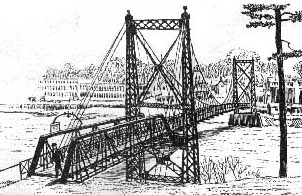 |
Kotlas - Waterville Area Sister City Connection P.O. Box 1747 Waterville, ME 04903-1747 Write to Us |
 |
 |
Kotlas - Waterville Area Sister City Connection P.O. Box 1747 Waterville, ME 04903-1747 Write to Us |
 |
|
Home > News > Archives > Natalia Kempers > Mending the Heart Natalia: Mending the Heart of Mother Russiaby Jean Ann Pollard World War I. America roaring. The crash of '29 still on the horizon. Picture winter. Snow. A big ice cutter churning up the White Sea, making a dash for freedom out of the port of Archangel, northeastern Russia. It's carrying hundreds of desperately escaping ''Whites'' — people loyal to the Russian Tsar and the old order — while the "Reds," the victorious communists, are panting on their trail. Lieutenant Von Rankhner is running on the heaving ice alongside the ship shouting, "Drop the rope! Drop the rope!" And passengers, watching, cheer as he grabs it, clambers up hand-over-hand, the last escapee as ice and winter and the anguish of the Solovetsky Islands, of the growing Gulag, closes behind them. Gulag: meaning concentration camp. But all is not pain and farewell. For on the cutter Lieutenant Von Rankhner meets his future wife. She is young, has been well educated at Smol'ny, the famous, elegant school for noble young ladies in St. Petersburg. She is a member of the intelligentsia, that group whom every dictator from Adolph Hitler to ldi Amin to Stalin seems to fear. And therefore hate. They must have exchanged names, the beautiful girl and the intrepid lieutenant: "My mother's father was murdered on the Solovetskys," she will report -if she knows about it. "My first husband is already dead in the Solovetskys, Lieutenant. My cousin is in a concentration camp somewhere near Kotlas." But, probably, she does not know the truth. It has taken 50 years for the incredible news to leak out -that something like 66 million citizens of the great continent which encompasses the Soviet Union have been systematically tortured and murdered in a system of extermination camps too extensive to be believable. '''My great-grandfather," he will reply, "was personal physician to the Tsar at his summer home in the Crimea." They flee to Yugoslavia, for it is in the south, and his few escaping friends are there. And, before he dies, they produce twin girls — one of whom is named Natalia Alexeevna Von Rankhner. Natalia! Fate is a funny thing. Who would have forecast that a little Russian emigré would make her own epic journey? That she would travel halfway around the world, be an American diplomat's wife, have four children, and settle, finally, in Waterville, Maine, to become — for 15 years — a librarian at Colby College? That she would marry professor John Kempers, a Dutchman who taught Russian there; translate Russian and Serbo-Croatian for the State Department and anyone else; be a hostess and friend to every international student in the vicinity; and initiate, with Dr. Peter Garrett, a sister-city relationship with Kotlas in the U.S.S.R — a city in the very region from which the brave lieutenant and his noble young lady escaped in the ice and desperation years before? Here is also an incredible story. Picture Yugoslavia, originally the Kingdom of Serbia, Croatia and Slovenia. Natalia Alexeevna has reached 20, is blond, petite, green-eyed, very beautiful. It is 1944. Her father is dead. Her older half-sister has died of consumption. She and her mother and twin sister receive word that Soviet troops are advancing. There is no snow this time but there is desperation: three female members of the "White" intelligentsia are in the path of victorious "Reds." They flee west and make it to Moravia — a pretty town on the Czech border in Austria — which by then is all Germany. They work in a candied-fruit factory. But, oh! the pain of acid constantly on hands because they can't afford gloves! And even this haven isn't to last. By 1945,with the defeat of the Third Reich, they receive word that Soviets are again advancing! Picture crumbling Europe, disintegrating Nazi battalions, Competing American and Soviet troops. What can three lovely women, two of whom are young, exquisite, do to save themselves from the rape and pillage of marauding soldiers? "We boarded a freight train, and got into a little compartment in an open car, and the next morning we looked up and the car was full of all kinds of bombs!" Natalia reports. "People are like ants, you know? How they all run around when they are disturbed? So we were all walking towards the west, many of us, towards the Americans. We were walking by night and sleeping by day in some little groves. It was 700 Bedraggled, exhausted, at last they reached Czechoslovakia where: "We got off the train and made our way towards Bavaria, where we were picked up and given a ride by Americans into Regensburg, a very old town. And there we became Displaced Persons." One can picture the Americans: G.I. Joes with close cropped heads and big, open grins, imagining they'd saved Europe once again from the villains it produces. Here she met her first husband, an American working for the Red Cross, who would became a diplomat for the State Department. "But before that he was a Columbia University student, and so, in 1946, I came to New York City." She'd made it! Out of the holocaust of Gulag, of the Second World War, someone very special had stepped ashore in America to reward it with her intelligence, courage — her history. This article originally appeared in the Morning Sentinel issue of July 6-7, 1991. It appears here by permission of the author. |